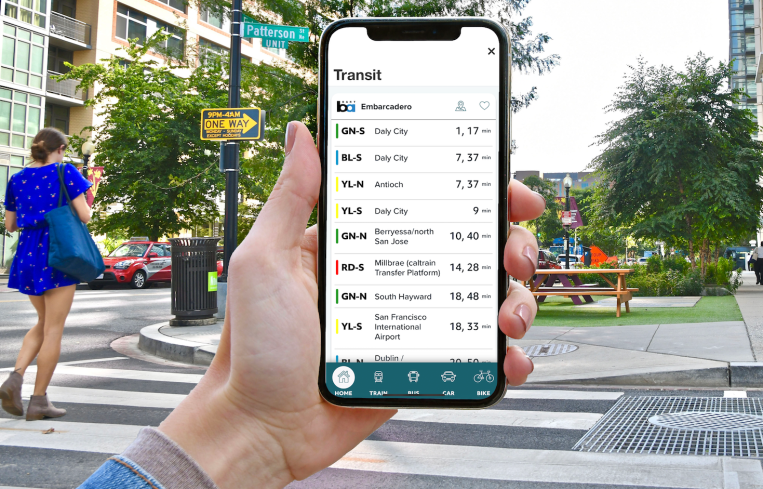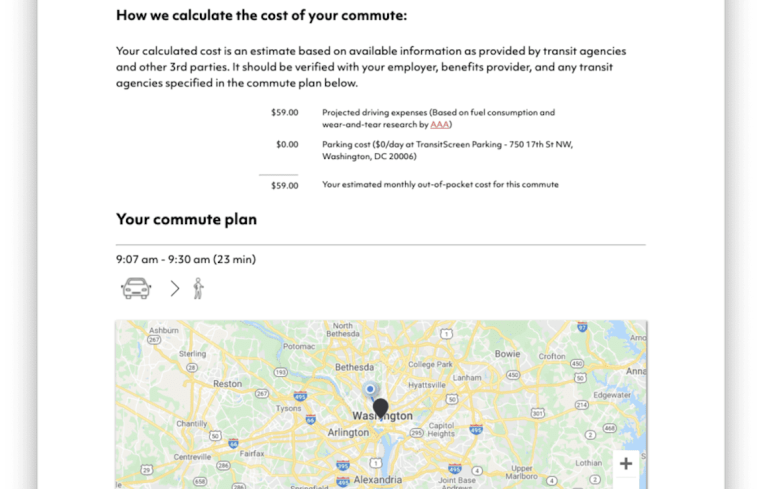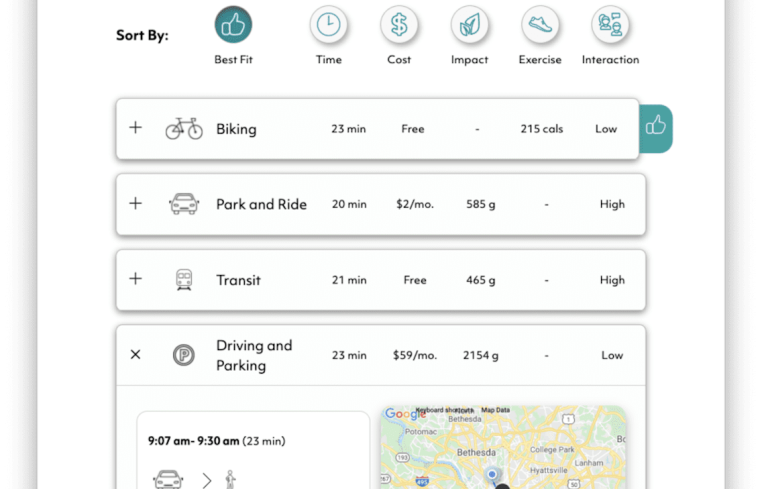Tech Firm TransitScreen Makes the Back-to-Work Commute More Convenient
By Keith Loria October 29, 2021 3:55 pm
reprints


Ever since Labor Day, many employees have been returning to in-person work for the first time since the pandemic began. Even if it’s only for a few days a week, it has still created traffic issues all across the Washington, D.C., region.
Add to that the recent Metro disruption — with reduced rides due to the system’s 7000-series trains being pulled from service — getting to and from work has been more challenging than ever.
That’s where TransitScreen comes in. The D.C.-based technology company’s core business helps workers discover commute options near specific buildings and other assets, allowing them to find the best route and means of transportation to get to the office. TransitScreen’s suite of apps is designed with employers in mind so they can help their employees get back to the office.
The company’s suite of apps provides real-time commuter information, up-to-the-minute schedules for the Metro and bus lines, information about the closest bike share docks and electric scooters, plus pricing for nearby rideshares such as Uber and Lyft — all in relation to the building one needs to get to for work.
“We offer every piece of information you need to get to the office or from the office,” Matt Caywood, CEO and co-founder of TransitScreen, told Commercial Observer. “There’s a lot of information that people can use to smooth their commute out on any given day.”
It also gives information on just how crowded the metro and bus are, which is more important than ever with people still anxious about taking public transportation in the COVID era.
The idea came to Caywood based on experiences he had as a graduate student in San Francisco, when he had choices of different transit options he could take from his lab. He created his own system to figure out what the best method would be to save time.
“When I moved to D.C. in 2010, I worked with some people in Arlington County on transportation demand management, using marketing and sales techniques, leveraging partners like the real estate community and employers to make the transportation system function more efficiently,” he said, noting it included things like getting people out of single-occupancy cars and reducing traffic.
TransitScreen came out of those efforts.
“If you’re an employer, you just can’t take a commute for granted anymore,” Caywood said.
Caywood’s first product was designed for developers looking to highlight transit options near particular assets, either for themselves or for potential tenants. Called TransitScreen, like the company itself, the product focuses on transportation networks on the local or asset level. Clients such as JBG Smith and Avalon Bay have utilized it to better position their buildings when leasing it or doing tours.
“On a tour there’s no time to take people to the Metro stations, you can’t show them all the bus stops and the bike shares, you need something like a TransitScreen, to make all that transportation seem concrete,” Caywood said. “That product’s grown to over 1,000 locations ranging from all the new apartment buildings in D.C., to the billboard outside Capital One, to the ballpark area.”
Building off of that, TransitScreen took its data platform, which included everything from buses, trains, ferries, public transit, bike shares and scooters, as well as private and smart parking, to help people with anything they would use to transport to and from a building. Thus, a mobile app was born.
CityMotion is that mobile solution, which Caywood describes as “Google Maps for your building or employer.” That includes all of the scheduling information, but additional details like availability of employee parking, company shuttle times and more. Employers can offer their employees this information so everyone knows what to expect on their commute.
A demo of the program starts with a view of all transportation modes available, with video messaging and branding capabilities.
The CityMotion experience allows someone to put in filters such as where you’re beginning and ending, time consideration, desire to exercise, cost considerations and benefit info and then the trip is optimized to offer the best way to get to work based on one’s parameters.
For example, someone who is interested in wellness and saving money might find that biking is the best option; or someone who wants to get to work the fastest, would learn the best Metro to make that happen. The app helps people stay on track with their commute each and every day. The AI engine will also make weather-based suggestions based on the forecast ahead.
And there are other solutions TransitScreen is doing as well, all designed to make things easier for commuters. Its newest is called CommuteWise.
“The newest products that we’re coming out with, are really game changes for the way that people are returning to the office,” Caywood said. “We have a tool called CommuteWise, which takes all the public information, the private information, and your employees’ benefits and special programs.”
For example, Amazon HQ2 has a $350 e-bike benefit that will let you lease one to get to the campus.
“You need something that integrates all of that into the planning process or else people are going to have a very fragmented process,” Caywood said. “You need a tool that automates that and CommuteWise solves that problem and then also gives employers a look into what the employees are looking at, and how they’re feeling about returning to the office.”
TransitScreen solutions are now available in other cities as well, including New York City.
One office customer in Manhattan did a survey of its tenants and found that the commute was the No. 1 barrier for getting back to the office, even greater than safety concerns or childcare challenges.
“That’s only getting worse as traffic is ramping up, and we are seeing what’s going to become a ‘carmageddon’ scenario in most major cities,” Caywood said. “D.C. may be one of the latest ones to have it hit, but we are going to see major congestion in New York, Los Angeles and everywhere else, so solutions are needed if we want to get them back in the building.”
He noted that from a major occupier’s perspective, such as a large employer, right now they are having a challenge getting employees to come in and commute to the office and very few are meeting the goals they set earlier in the year.
“People being forced to do a commute that they don’t want to do after working from home for a substantial amount of time,” Caywood said. “You’re going to start seeing massive employee turnover. A third of people say they do not want to go back and commute right now. Some of those people want to stay forever, but could be convinced back with the right assistance, the right amenities and the right incentives.”
Looking ahead to 2022, TransitScreen will focus on new solutions that help to solve problems that employees or residents of buildings have by increasing its focus on the real estate industry with data and analytics.
Keith Loria can be reached at Kloria@commercialobserver.com.


